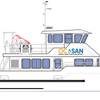With faster speeds and lighter hulls, ship builders and owners require lightweight equipment. Maritime Dynamics will be incorporating weigh saving features into its ride control system to address this challenge.
The first measure has been to design the ride control hydraulics system to operate other onboard equipment. Maritime Dynamics offers hydraulic packs, which, in addition to the ride control system, operate the propulsion waterjet steering, and reversing system. During docking maneuvers, the power packs can operate car ramps, capstans and anchor winches.
This summer, Maritime Dynamics will install its first commercial computer-based ride control system with an embedded Microsoft Windows operating system. The new system will offer touch screen operation, improved diagnostic capabilities, easy integration with alarm and monitoring systems and redundant backup controls. System interconnection will be via fiberoptic cable. Preliminary estimates show the switch from conventional copper cable to fiberoptic cable will result in a 40 percent weight savings.
Also, Maritime Dynamics now offers composite trim tabs, a proven method for controlling pitch and roll motions. Preliminary estimates forecast a 70 percent weight savings over an equivalent steel trim tab.
The company's recent ride control system installations include Incat's Hull 050, Trico Marine's Stillwater River, Derecktor Shipyard's Patricia Olivia II, Fincantieri's Superseacat III and IV and Catamaran Ferries International's Pacificat. These installations increase the number of vessels commissioned with a Maritime Dynamics ride control system to more than 140.
Sponsored Content
Lower carbon intensity fuels to support your operations

Subscribe for
Maritime Reporter E-News
Maritime Reporter E-News is the maritime industry's largest circulation and most authoritative ENews Service, delivered to your Email five times per week










